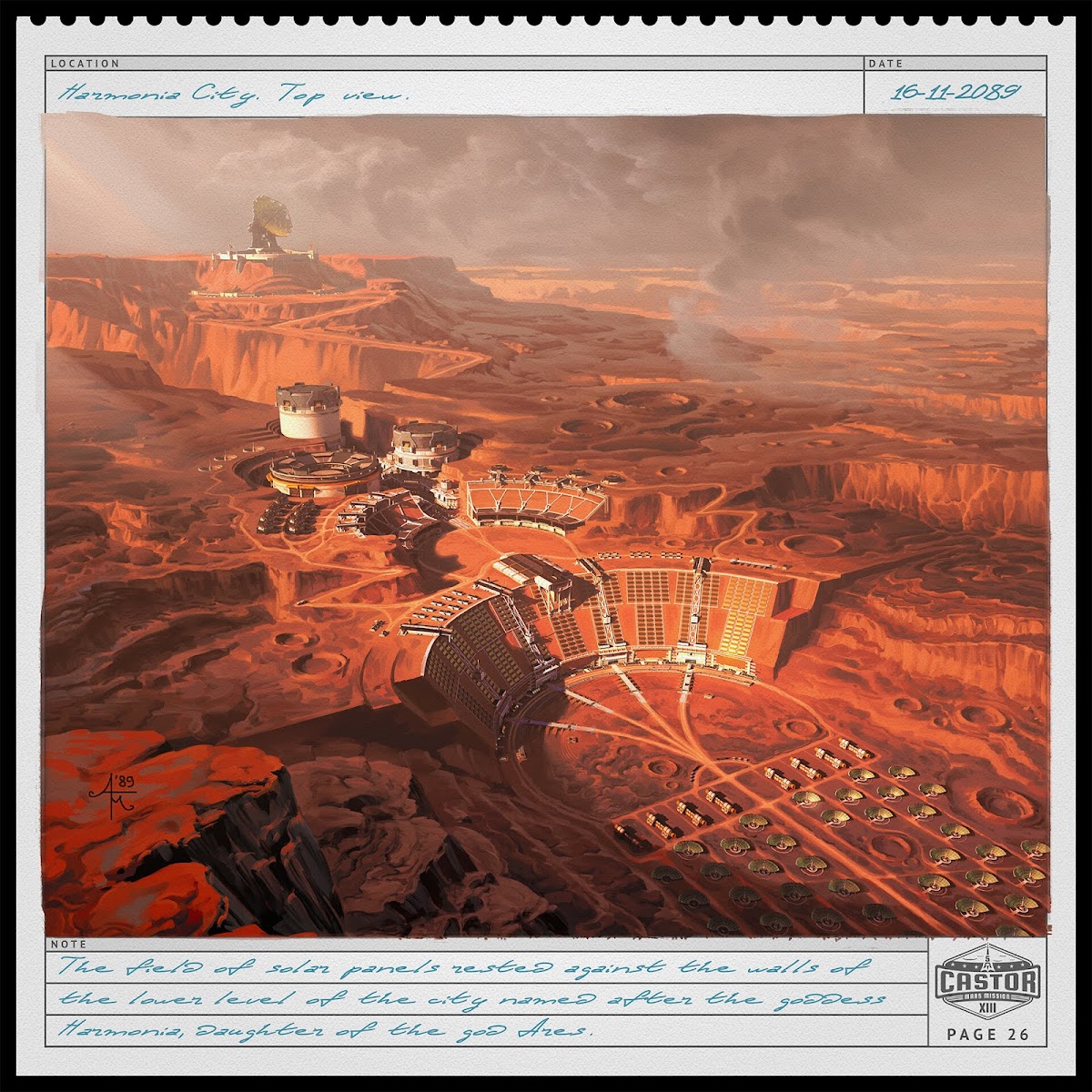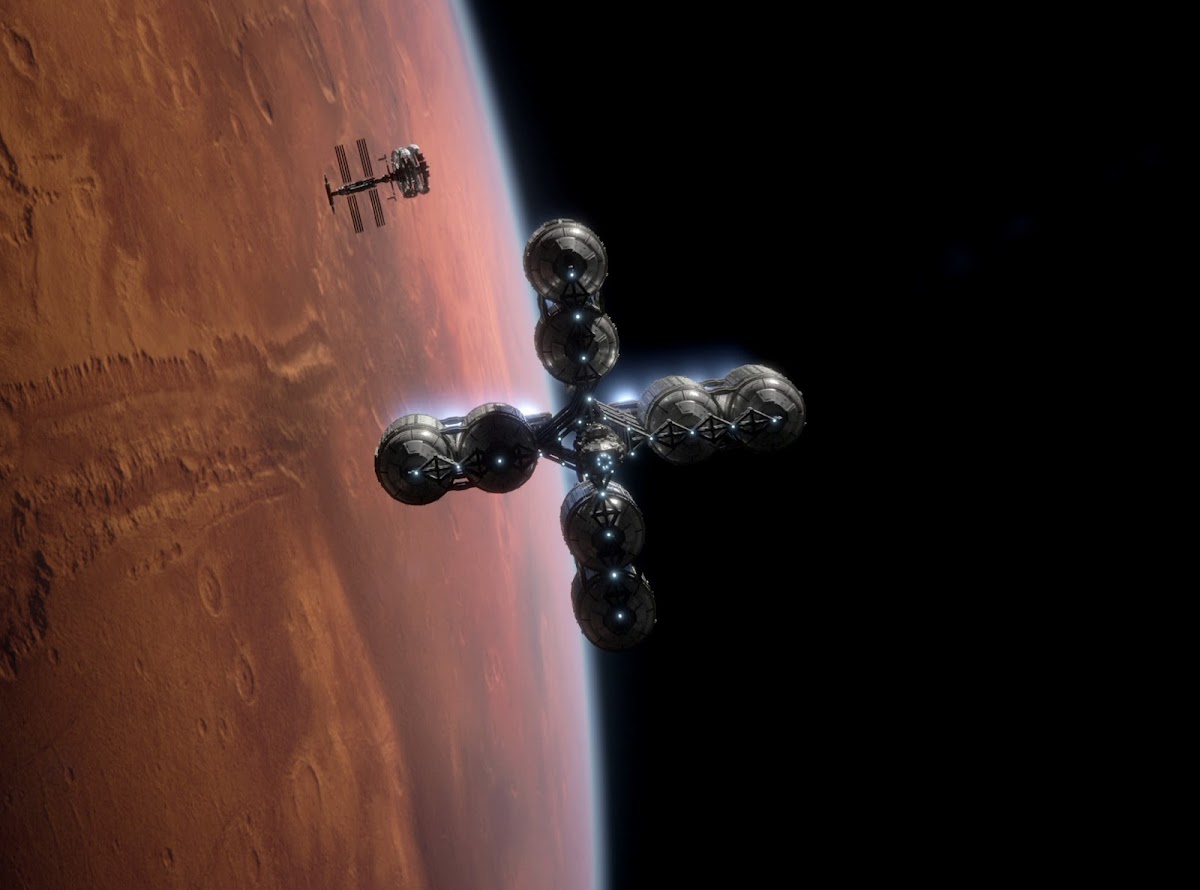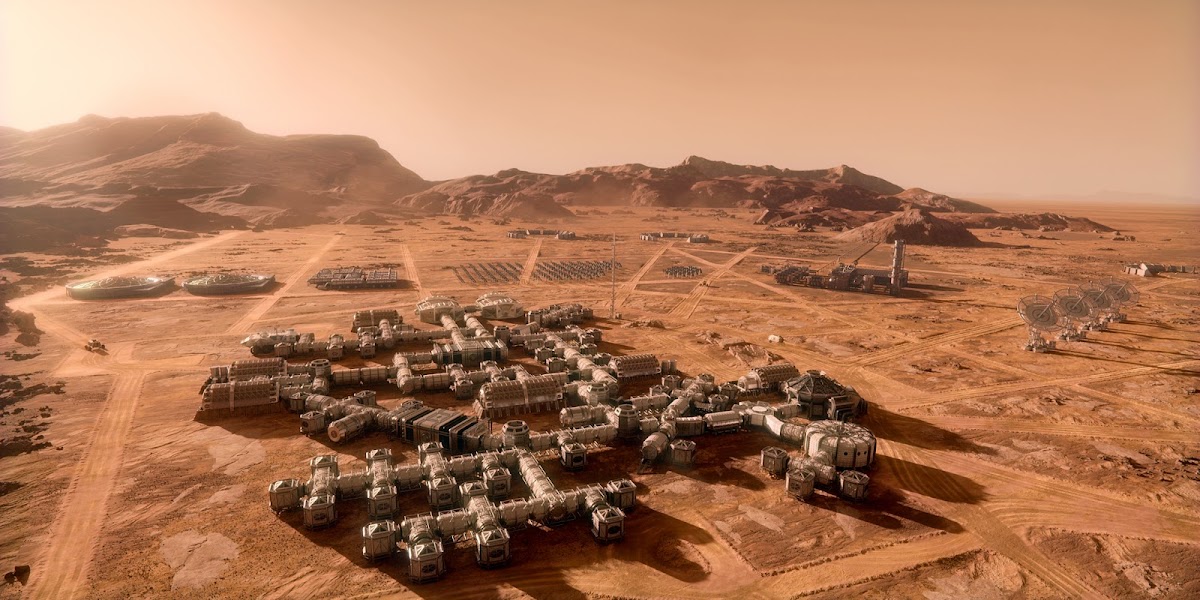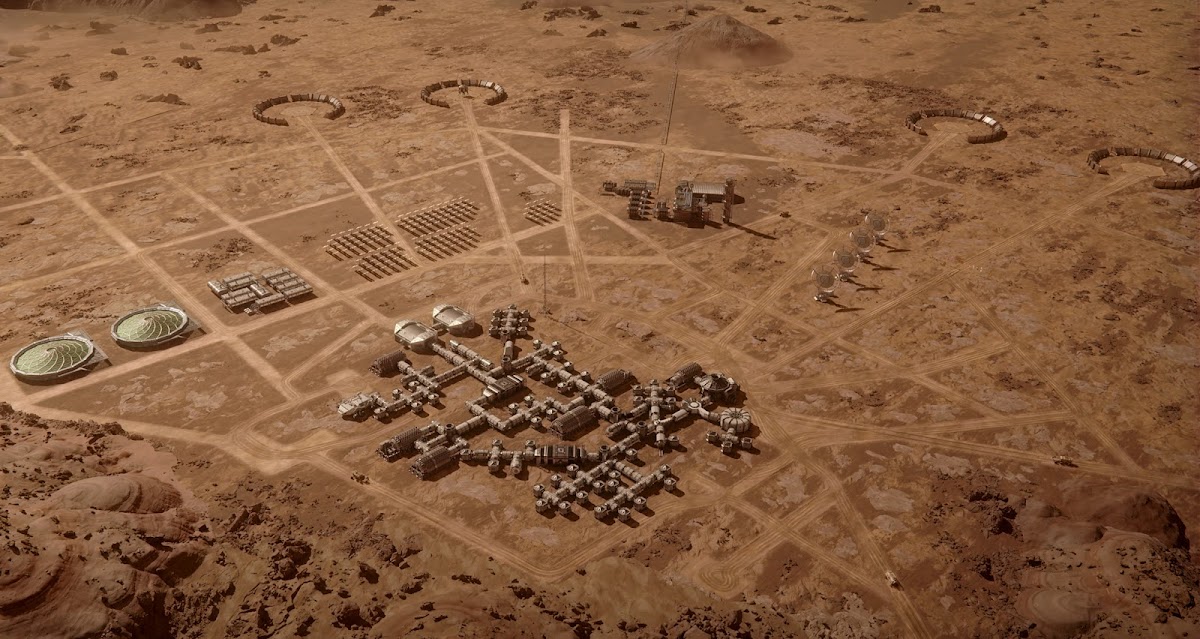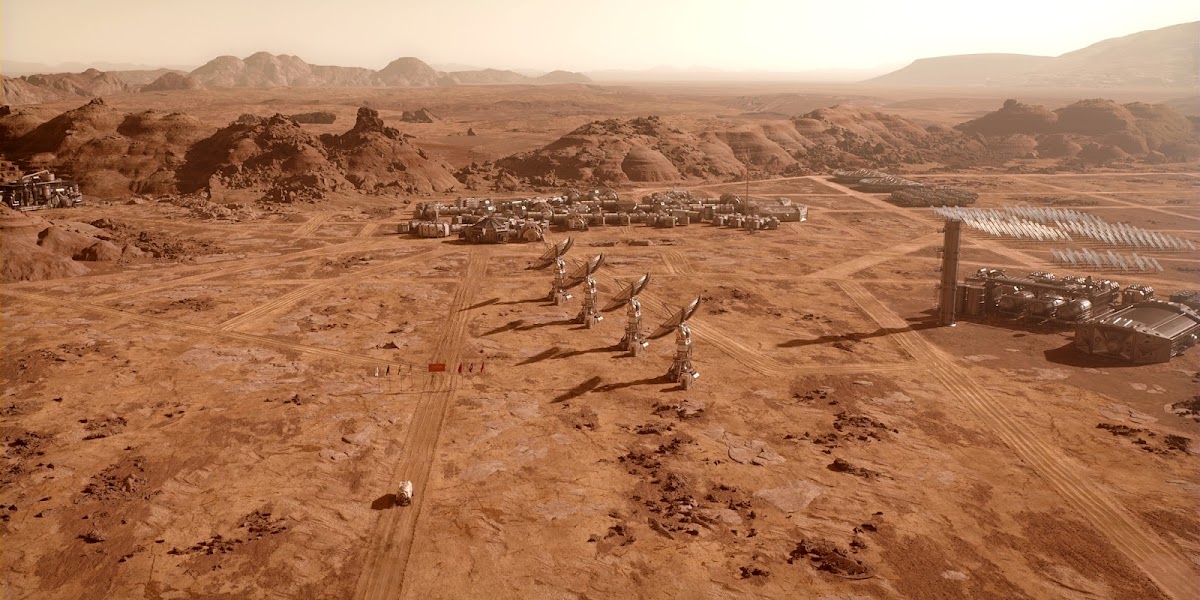Here is a poster "Join us on Mars" by Canadian illustrator Jode Thompson created for Jacob Haqq-Misra's article "Liberate the Red Planet" published on Boston Globe.
The poster features a retro-futuristic art style reminiscent of mid-20th-century sci-fi. The composition showcases a vibrant, warm-toned Martian landscape with jagged red rock formations. Silhouetted against this backdrop are two figures in space suits, standing side by side, gazing at the horizon where futuristic, antenna-topped structures hover above the terrain. Bold, stylized text proclaims "Join us on MARS" at the top, with "Apply for Citizenship Today" at the bottom, evoking a sense of adventure and possibility in a new frontier. The poster's textured, slightly distressed finish enhances its vintage aesthetic, blending nostalgia with a vision of interplanetary exploration.
Showing posts with label Mars Colonization. Show all posts
Showing posts with label Mars Colonization. Show all posts
Monday, April 14, 2025
Sunday, April 6, 2025
Mars base model by Zuzanna Skąpska
A set of renders for a Mars base model created by Polish 3D artist Zuzanna Skąpska for Mission to Mars AR app, an interactive augmented reality experience allowing users to drive a rover, launch a rocket, and explore the Red Planet. The app was created by Immersion Labs for Smithsonian Institution and with collaboration with NASA.
The Mars base model presents a modular and expandable habitat system intended for human settlement on Mars. It comprises multiple interconnected cylindrical modules, each serving distinct functions such as living quarters, research labs, or storage. The central module, marked with "MARS 2020" and an American flag, serves as the primary living area, equipped with communication equipment and access points for surface operations. Adjacent to this is a domed greenhouse structure, crucial for growing food and supporting human life in the base. The design incorporates protective features against Mars' harsh conditions, including radiation shielding, and allows for future expansion as the base grows.
The Mars base model presents a modular and expandable habitat system intended for human settlement on Mars. It comprises multiple interconnected cylindrical modules, each serving distinct functions such as living quarters, research labs, or storage. The central module, marked with "MARS 2020" and an American flag, serves as the primary living area, equipped with communication equipment and access points for surface operations. Adjacent to this is a domed greenhouse structure, crucial for growing food and supporting human life in the base. The design incorporates protective features against Mars' harsh conditions, including radiation shielding, and allows for future expansion as the base grows.
Monday, December 30, 2024
New Year's Eve fireworks at a Martian colony
Celebrating New Year's Eve with fireworks at a human colony on Mars - a screenshot from 2022 science fiction teen comedy "Moonshot" set in 2049 when trips to Mars has become routine for skilled or wealthy people.
Sunday, December 1, 2024
SpaceX Starship mission to Mars in 2030 - animated story by iamVisual
Saturday, September 28, 2024
Garden inside a dome on Mars by Bryan Versteeg
Canadian concept artist Bryan Versteeg has created a concept of a human base on Mars featuring a recreational garden inside a small crater covered with a transparent dome.
Saturday, September 7, 2024
Garden under a geodesic dome
Picture of the Day 07/09/2024 - design of a garden under a geodesic dome for the King Salman Park in Riyadh, Saudi Arabia to be opened this year as the largest urban park in the world. Public gardens in future Arab settlements on Mars could look similar as this design.
Saturday, August 3, 2024
The colonization of Mars in "The Martian Chronicles" (1980) TV series
The Martian Chronicles is a 1980 television 3-episode miniseries based on Ray Bradbury's 1950 science fiction novel with the same name The Martian Chronicles which was originally not written as a singular work but as short stories published separately in late 1940s.
The novel and TV series chronicles the exploration and settlement of Mars, the home of indigenous Martians, at the beginning of 21st century when human settlers leave the troubled Earth that is eventually devastated by a nuclear war. The series depicts Mars as having a "thin atmosphere" which humans can breathe, with desert-like vegetation and water-filled canals, cities and other alien structures built by the indigenous Martians thousands of years ago.
The Martian Chronicles TV series, aired on 1980, is one of the few works of science fiction to depict Mars, in the period between the initial Mars enthusiasm that ended in the 1960s, characterized by fear of hostile Martians, and the revival of Mars-related science fiction in the 2000s already without the Martians.
The Martian Chronicles are divided into three parts / episodes:
The novel and TV series chronicles the exploration and settlement of Mars, the home of indigenous Martians, at the beginning of 21st century when human settlers leave the troubled Earth that is eventually devastated by a nuclear war. The series depicts Mars as having a "thin atmosphere" which humans can breathe, with desert-like vegetation and water-filled canals, cities and other alien structures built by the indigenous Martians thousands of years ago.
The Martian Chronicles TV series, aired on 1980, is one of the few works of science fiction to depict Mars, in the period between the initial Mars enthusiasm that ended in the 1960s, characterized by fear of hostile Martians, and the revival of Mars-related science fiction in the 2000s already without the Martians.
The Martian Chronicles are divided into three parts / episodes:
- The Expeditions - the exploration of Mars begins with two failed expeditions. Colonel Wilder then leads a 3rd crew to discover the secret of Mars - only to find all the Martians dead from chicken pox.
- The Settlers - with native Martians wiped out by disease, thousands of humans now colonize the red planet and attempt to create a second Earth.
- The Martians - with Earth destroyed in a nuclear war, there are only a few survivors on Mars, including Wilder's family. To rebuild what he has lost, Wilder chooses to make Mars his new home.
First expeditions to Mars:
Saturday, July 20, 2024
A long night on Mars in "Fort Solis" thriller game
Fort Solis (2023) is a cinematic narrative-driven science fiction thriller game set in 2080 on Mars. During a night engulfed in a severe sandstorm two mining engineers, Jack and Jessica, respond to an unusual emergency alert from a mining and research station "Fort Solis". The station is on lockdown and seems to be abandoned. The pair separately starts to investigate, what has happened in the base, searching for clues throughout the claustrophobic buildings. Piece by piece they unlock both the various parts of the base and the truth behind recent events there. The game starts as a detective and ends as a thriller.
Fort Solis runs on Unreal Engine 5.2 so visually it is really good, especially the character models and animations. The game is not long, you can finish it in 5 to 8 hours even when reading, watching and listening to all of the clues throughout the base. The story will unfold linearly piece by piece, but there are two separate endings possible in the final act of the game.
Fort Solis runs on Unreal Engine 5.2 so visually it is really good, especially the character models and animations. The game is not long, you can finish it in 5 to 8 hours even when reading, watching and listening to all of the clues throughout the base. The story will unfold linearly piece by piece, but there are two separate endings possible in the final act of the game.
Visual recap of Fort Solis' STORY
Jack and Jessica are working at a mining rig on Mars
When receiving the emergency allert Jack is driving to the mining station "Fort Solis"
"Fort Solis" is on lockdown
Thursday, July 4, 2024
Search for a lost colony on Mars in "Deliver Us Mars" adventure game
Sequel to Deliver Us The Moon (2019), Deliver Us Mars (2023) is an atmospheric sci-fi adventure game set in mid-21st century when the ecosystem of Earth is close to extinction due to the effects of climate change. After a mysterious distress call from Mars, Earth’s youngest astronaut Kathy joins an expedition to recover the ARK colony ships stolen more than decade ago by the mysterious science-oriented organization Outward (Kathy's father Isaac is among the leaders of Outward).
Although the story of Deliver Us Mars is strictly linear and you as a player can't impact it, the story itself is well-written and interesting, revealing the truth about the fate of Outward colonists on Mars piece by piece. Some parts of the game felt like a true detective. The atmospheric visual and audial mood of the scenes complements the story well and the final act of Deliver Us Mars features one of the most compelling representations of a human colony on Mars in video games, feeling almost utopian.. especially comparing it to the dying Earth.
Unfortunately, this aspect also leads to some frustration with the strictly linear nature of the game's storytelling - you can't change the main character's endgame decision, no matter how stupid you think it is. Another source of a frustration with the game for some players will be the clunky wall climbing mechanics. Regardless these small issues Deliver Us Mars is a must-play game for any Mars fan.
Although the story of Deliver Us Mars is strictly linear and you as a player can't impact it, the story itself is well-written and interesting, revealing the truth about the fate of Outward colonists on Mars piece by piece. Some parts of the game felt like a true detective. The atmospheric visual and audial mood of the scenes complements the story well and the final act of Deliver Us Mars features one of the most compelling representations of a human colony on Mars in video games, feeling almost utopian.. especially comparing it to the dying Earth.
Unfortunately, this aspect also leads to some frustration with the strictly linear nature of the game's storytelling - you can't change the main character's endgame decision, no matter how stupid you think it is. Another source of a frustration with the game for some players will be the clunky wall climbing mechanics. Regardless these small issues Deliver Us Mars is a must-play game for any Mars fan.
Visual recap of Deliver Us Mars' STORY
Be aware of heavy spoilers, revealing major story plots.Even before getting to Mars the expedition is riddled with severe problems
Game's protagonist (main character) is Earth’s youngest astronaut Kathy searching for her father among the lost colonists on Mars
Kathy lands near an abandoned mining facility
Sunday, May 26, 2024
Martian city in "Chaser"
Chaser is an old first-person shooter released on 2003. Today there is no shortage of video games set on Mars, but back then Chaser was one of the few, even if only less than half of the game actually takes place on Mars. It follows a story somewhat similar to that of Arnold Schwarzenegger's famous movie Total Recall (1990) and I reviewed the game here 10 years ago.
Recently I made a second playthrough of the game. Part of Chaser's story takes place in a city on Mars under a large dome and here are some screenshots of the city:
Saturday, April 13, 2024
SpaceX Starship update 2024
 On April 4th at Starbase, Texas SpaceX CEO and lead designer Elon Musk provided an unannounced update of SpaceX's Starship architecture. Here are slides and animations from his presentation.
On April 4th at Starbase, Texas SpaceX CEO and lead designer Elon Musk provided an unannounced update of SpaceX's Starship architecture. Here are slides and animations from his presentation.
Full presentation:
Slides from the presentation
Starship v1, v2 and v3 specifications:
Thrust comparison of Raptor v1, v2 and v3:
First Mechazilla launch tower pairs at Starbase, Texas and Cape Canaveral, Florida:
Saturday, February 24, 2024
Harmonia City - Part 5 of Martian sketches by Andrey Maximov
 Environment concept artist Andrey Maximov from Armenia has created an impressive set of artworks called Martian sketches depicting a "routine" journey to Mars in 2089. So far he has published 30 pages of those sketches. As the artist describes them: "this series is kind of like the road sketches of a member of an expedition to Mars. It's a routine flight in the not-too-distant future. The planet is more or less inhabited. We have an orbital station around Mars. There are already several settlements on the surface, mining is going on."
Environment concept artist Andrey Maximov from Armenia has created an impressive set of artworks called Martian sketches depicting a "routine" journey to Mars in 2089. So far he has published 30 pages of those sketches. As the artist describes them: "this series is kind of like the road sketches of a member of an expedition to Mars. It's a routine flight in the not-too-distant future. The planet is more or less inhabited. We have an orbital station around Mars. There are already several settlements on the surface, mining is going on."
- 1st part (10 sketches) of Andrey's Martian sketches depicted the expedition leaving Earth;
- 2nd part (5 sketches) depicted expedition's arrival to "International Mars Orbital Station";
- 3rd part (6 sketches) depicted spaceport "Anteros" on Mars.
- 4th part (4 sketches) depicted expedition's road to the "Harmonia City".
Here is 5th part (5 sketches) depicting the multi-leveled "Harmonia City" on Mars:
Sunday, February 18, 2024
SpaceX Starship next to a solar farm on Mars
Saturday, January 27, 2024
Road to the City - Part 4 of Martian sketches by Andrey Maximov
 Environment concept artist Andrey Maximov from Armenia has created an impressive set of artworks called Martian sketches depicting a "routine" journey to Mars in 2089. So far he has published 30 pages of those sketches. As the artist describes them: "this series is kind of like the road sketches of a member of an expedition to Mars. It's a routine flight in the not-too-distant future. The planet is more or less inhabited. We have an orbital station around Mars. There are already several settlements on the surface, mining is going on."
Environment concept artist Andrey Maximov from Armenia has created an impressive set of artworks called Martian sketches depicting a "routine" journey to Mars in 2089. So far he has published 30 pages of those sketches. As the artist describes them: "this series is kind of like the road sketches of a member of an expedition to Mars. It's a routine flight in the not-too-distant future. The planet is more or less inhabited. We have an orbital station around Mars. There are already several settlements on the surface, mining is going on."
- 1st part (10 sketches) of Andrey's Martian sketches depicted the expedition leaving Earth;
- 2nd part (5 sketches) depicted expedition's arrival to "International Mars Orbital Station";
- 3rd part (6 sketches) depicted spaceport "Anteros" on Mars.
Here is 4th part (4 sketches) depicting expedition's road to the "Harmonia City" on Mars:
Sunday, January 14, 2024
How to steal an asteroid .. "For All Mankind" season 4
It's possible our judgement is biased towards Mars-related content, but season 4 of For All Mankind alternate history sci-fi TV series is show's most exciting season yet. In season 4, depicting the alternate 2003, the international Happy Valley Base, founded in 1995 during season 3, has been significantly expanded and there are around 200 people living in it. We made a separate article with a large collection of high resolution shots depicting the exterior and interior of Happy Valley Base:
Mars base for 200 people in For All Mankind season 4
The main theme in season 4 is increasingly diverging visions for the purpose of human presence on Mars. For some it's only another contract job, but for others Mars is a new place to call "home". Add to the mix a once-in-a-lifetime opportunity to get hold on a large lithium-rich asteroid and increasingly strained relationships between the "upper class" (astronauts / cosmonauts, scientists and top executives) and contract workers literally living underground, and you have a recipe for a "Martian rebellion".
For All Mankind is exploring the idea of never ending space race if Soviets would have beaten US in the race for the Moon and the intention of the show is each season to jump about a decade further into the increasingly diverging reality of the show: in season 1, depicting alternate 1969 to 1974, both Soviets and US start building their separate bases near the lunar South pole; in season 2 (1983) both bases have been expanded and the superpowers compete for resources on the Lunar surface; in season 3 (1992 to 1995), Soviets and US are joined by a private company Helios and North Korea for a four way race to be first on Mars; in season 4 (2003) there is a sprawling international human base on Mars and an unexpected side enters the race to get hold on a large, lithium-rich asteroid for mining. You can watch the show on Apple TV+
Ahead there is a VISUAL RECAP OF SEASON 4, consisting of high resolution shots, downscaled from 4K UHD screens for better image quality. Be aware of heavy spoilers, revealing major story plots:
Mars base for 200 people in For All Mankind season 4
The main theme in season 4 is increasingly diverging visions for the purpose of human presence on Mars. For some it's only another contract job, but for others Mars is a new place to call "home". Add to the mix a once-in-a-lifetime opportunity to get hold on a large lithium-rich asteroid and increasingly strained relationships between the "upper class" (astronauts / cosmonauts, scientists and top executives) and contract workers literally living underground, and you have a recipe for a "Martian rebellion".
For All Mankind is exploring the idea of never ending space race if Soviets would have beaten US in the race for the Moon and the intention of the show is each season to jump about a decade further into the increasingly diverging reality of the show: in season 1, depicting alternate 1969 to 1974, both Soviets and US start building their separate bases near the lunar South pole; in season 2 (1983) both bases have been expanded and the superpowers compete for resources on the Lunar surface; in season 3 (1992 to 1995), Soviets and US are joined by a private company Helios and North Korea for a four way race to be first on Mars; in season 4 (2003) there is a sprawling international human base on Mars and an unexpected side enters the race to get hold on a large, lithium-rich asteroid for mining. You can watch the show on Apple TV+
Ahead there is a VISUAL RECAP OF SEASON 4, consisting of high resolution shots, downscaled from 4K UHD screens for better image quality. Be aware of heavy spoilers, revealing major story plots:
During season 4 interplanetary ships don't land directly on Mars; instead they dock to Phoenix, orbiting Mars, and the rest of the trip is made via small shuttles heading down to the surface:
Ed and Svetlana flying the asteroid capture ship Ranger:
Season 4 starts with an unsuccessful asteroid capture mission:
Wednesday, January 10, 2024
Mars base for 200 people in "For All Mankind" season 4
Season 4 of For All Mankind alternate history sci-fi TV series, depicting alternate 2003, "is really about the building of a new civilization on Mars" by the words of the co-creator of the series Ben Nedivi. The international Happy Valley Base, founded in 1995 during season 3 and located in Melas Chasma in the Valles Marineris canyon system on Mars, has been significantly expanded and there are around 200 people living in the base during season 4. The base is financed and operated by Mars-7 Alliance (consisting of US, USSR, ESA, North Korea, India, Japan, and the Coalition of Communist Countries for Spaceflight (CCCS)) and maintained by a private company Helios Aerospace.
Ground level of the base features several separate facilities for power generation, communications, fuel refinement, regolith processing, algae production, storage etc. and a central interconnected cluster of modules consisting of the Entrance hall for new arrivals with airlocks for the rovers, control rooms, laboratories, hydroponic farms, meeting rooms, warehouses / garages, a cafeteria, as well as the quarters for higher level personnel and astronauts / cosmonauts. The base has 5 underground sublevels, of which level 4 & 5 are still under construction in 2003 and not accessible. The sublevels house maintenance and storage rooms and additional quarters for workers. There is also a separate North Korean sector accessible only to North Koreans. The base also operates six landing pads for their orbital Hopper shuttles.
The design of the Happy Valley Base in For All Mankind is the most plausible design of a mid-sized human base on Mars that we have ever seen in a TV series or film.
For All Mankind is exploring the idea of never ending space race if Soviets would have beaten US in the race for the Moon and the intention of the show is each season to jump about a decade further into the increasingly diverging reality of the show: in season 1, depicting alternate 1969 to 1974, both Soviets and US start building their separate bases near the lunar South pole; in season 2 (1983) both bases have been expanded and the superpowers compete for resources on the Lunar surface; in season 3 (1992 to 1995), Soviets and US are joined by a private company Helios and North Korea for a four way race to be first on Mars; in season 4 (2003) there is a sprawling international human base on Mars and an unexpected side enters the race to get hold on a large, lithium-rich asteroid for mining.
Here we collected high resolution shots from season 4 (downscaled from 4K UHD screens for better image quality) depicting the exterior and interior of Happy Valley Base on Mars. No images revealing major story plots are included. We will make a separate article with season 4 story spoilers after the last episode will be released on January 12. [UPDATED:]
How to steal an asteroid .. "For All Mankind" season 4
Ground level of the base features several separate facilities for power generation, communications, fuel refinement, regolith processing, algae production, storage etc. and a central interconnected cluster of modules consisting of the Entrance hall for new arrivals with airlocks for the rovers, control rooms, laboratories, hydroponic farms, meeting rooms, warehouses / garages, a cafeteria, as well as the quarters for higher level personnel and astronauts / cosmonauts. The base has 5 underground sublevels, of which level 4 & 5 are still under construction in 2003 and not accessible. The sublevels house maintenance and storage rooms and additional quarters for workers. There is also a separate North Korean sector accessible only to North Koreans. The base also operates six landing pads for their orbital Hopper shuttles.
The design of the Happy Valley Base in For All Mankind is the most plausible design of a mid-sized human base on Mars that we have ever seen in a TV series or film.
For All Mankind is exploring the idea of never ending space race if Soviets would have beaten US in the race for the Moon and the intention of the show is each season to jump about a decade further into the increasingly diverging reality of the show: in season 1, depicting alternate 1969 to 1974, both Soviets and US start building their separate bases near the lunar South pole; in season 2 (1983) both bases have been expanded and the superpowers compete for resources on the Lunar surface; in season 3 (1992 to 1995), Soviets and US are joined by a private company Helios and North Korea for a four way race to be first on Mars; in season 4 (2003) there is a sprawling international human base on Mars and an unexpected side enters the race to get hold on a large, lithium-rich asteroid for mining.
Here we collected high resolution shots from season 4 (downscaled from 4K UHD screens for better image quality) depicting the exterior and interior of Happy Valley Base on Mars. No images revealing major story plots are included. We will make a separate article with season 4 story spoilers after the last episode will be released on January 12. [UPDATED:]
How to steal an asteroid .. "For All Mankind" season 4
Subscribe to:
Posts (Atom)





 Canadian VFX artist and YouTuber
Canadian VFX artist and YouTuber 


























